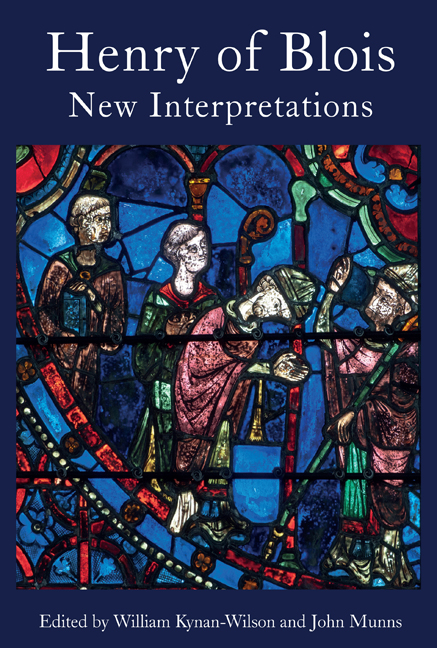Book contents
- Frontmatter
- Dedication
- Contents
- List of Illustrations
- List of Contributors
- Acknowledgements
- List of Abbreviations
- Genealogical Table: The Family Connections of Henry of Blois
- Introduction: Approaches to Henry of Blois
- 1 Causa Dei Et Ecclesie Cluniacensis: Henry of Blois and Cluny
- 2 Henry of Blois and His Legation in England
- 3 The Episcopal Colleagues of Henry of Blois
- 4 The Architectural Heritage of Bishop Henry of Blois at Winchester Cathedral
- 5 Wolvesey: Henry of Blois’ Domus Quasi palatium in Winchester
- 6 Bishop Henry’s Bible
- 7 Henry of Blois and the Construction of Roman Identity
- 8 Henry of Blois: Between Patronage and Representation in the Long Twelfth Century
- 9 The Last Days of Henry of Blois
- Timeline
- Bibliography
- Index
- Plate Section
5 - Wolvesey: Henry of Blois’ Domus Quasi palatium in Winchester
Published online by Cambridge University Press: 09 February 2021
- Frontmatter
- Dedication
- Contents
- List of Illustrations
- List of Contributors
- Acknowledgements
- List of Abbreviations
- Genealogical Table: The Family Connections of Henry of Blois
- Introduction: Approaches to Henry of Blois
- 1 Causa Dei Et Ecclesie Cluniacensis: Henry of Blois and Cluny
- 2 Henry of Blois and His Legation in England
- 3 The Episcopal Colleagues of Henry of Blois
- 4 The Architectural Heritage of Bishop Henry of Blois at Winchester Cathedral
- 5 Wolvesey: Henry of Blois’ Domus Quasi palatium in Winchester
- 6 Bishop Henry’s Bible
- 7 Henry of Blois and the Construction of Roman Identity
- 8 Henry of Blois: Between Patronage and Representation in the Long Twelfth Century
- 9 The Last Days of Henry of Blois
- Timeline
- Bibliography
- Index
- Plate Section
Summary
For over a thousand years the bishops of Winchester have lived at Wolvesey. The 97th bishop, the Rt Revd Tim Dakin, and his family live there today, not in the ruins of the great medieval palace, but in the west wing, the only surviving part of a vast baroque palace begun for George Morley (bishop, 1662–84) by Sir Thomas Fitch over the south-west corner of the then already ruined medieval palace [Fig. 5.1; Plate II].
Everything about Wolvesey is both very old and very large. And the oldest and largest element, still intact today, is the enclosure within which the palace of the medieval bishops stood and the palace in its present form stands today.
The Wolvesey enclosure [Figs 5.2–5.3]
The name ‘Wolvesey’ is first recorded in the form Wolves’ in the thirteenth-century Annals of Worcester in relation to the year 1138, but more fully as Wlveseia in the Winchester Pipe Rolls for 1208–9 and 1210–11. As an area-name with the probable meaning ‘Wulf's island’, this seems to refer to an enclosure of higher or firmer ground in the valley floor. Nothing is known of ‘Wulf’ but his name probably recalls an owner or occupier of the ground on which the bishops of Winchester were later to make their home.
This enclosure seems to have been created by Athelwold (bishop, 963–84) who reformed the monastic communities of the Old and New Minsters and the Nunnaminster, replacing the clerics and sisters with monks and nuns, redefining their boundaries, and enclosing the Nunnaminster with a wall. Ætelwold's imposition on the minsters of a monastic regime organised within strict spatial boundaries would have made it essential to separate the socially and administratively demanding routine of a bishop's household from that of these now strictly enclosed communities. Part and parcel of this definition of precincts seems to have been the creation of a separate residence for the bishop in an enclosure of 3.7ha (9.1 acres) then apparently already associated with the name of Wulf, and still Wolvesey today.
- Type
- Chapter
- Information
- Henry of BloisNew Interpretations, pp. 119 - 144Publisher: Boydell & BrewerPrint publication year: 2021



